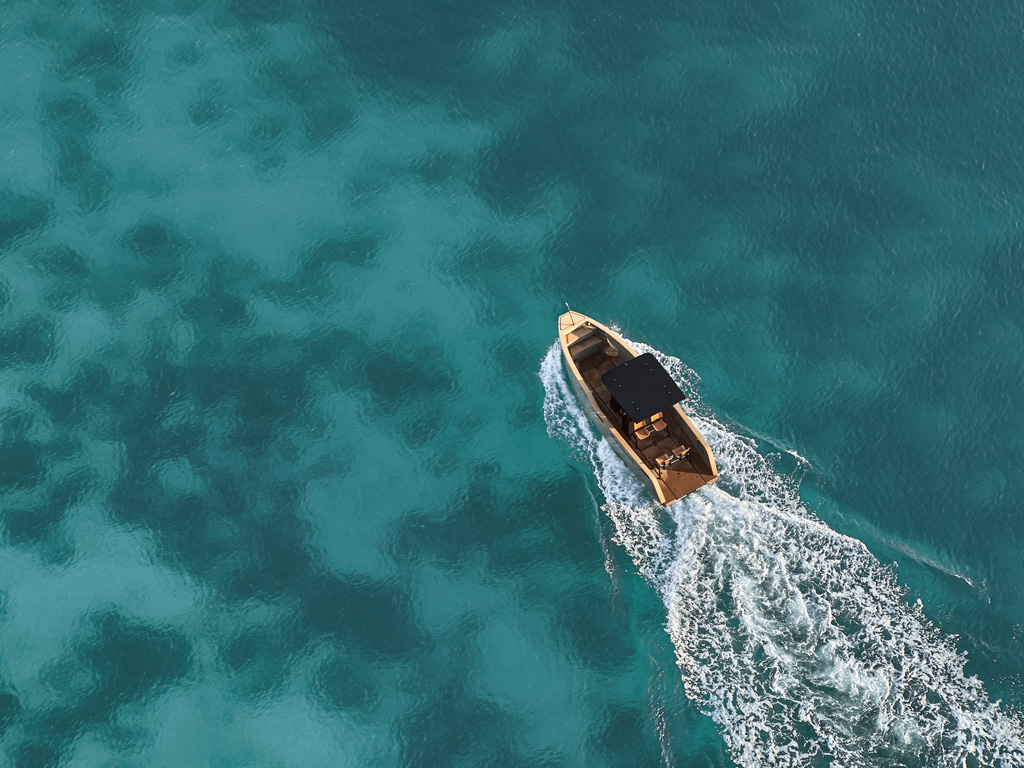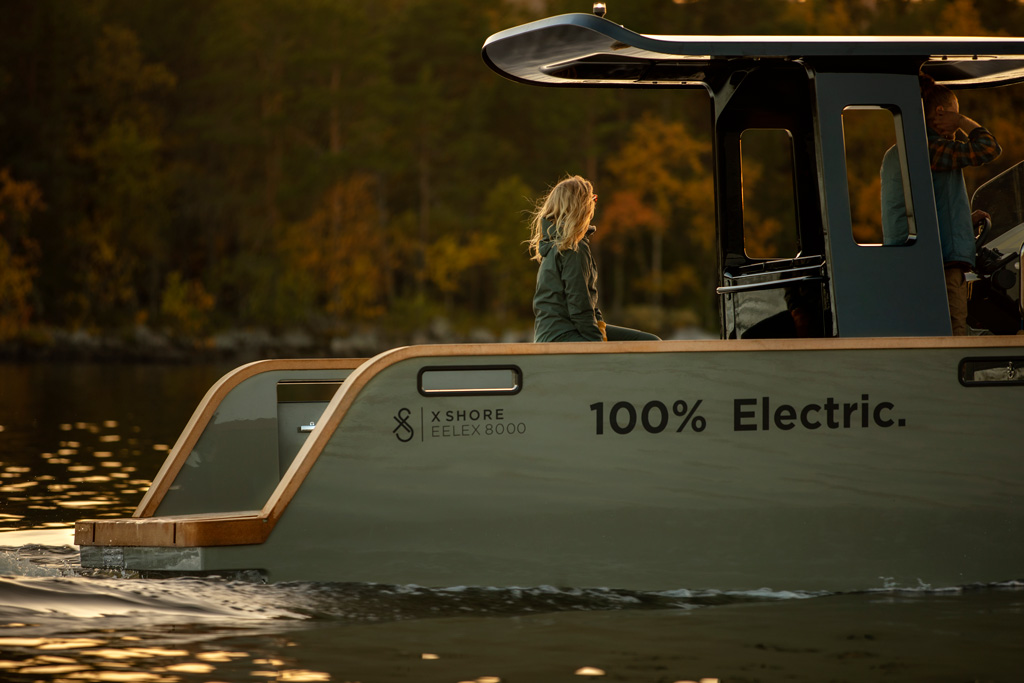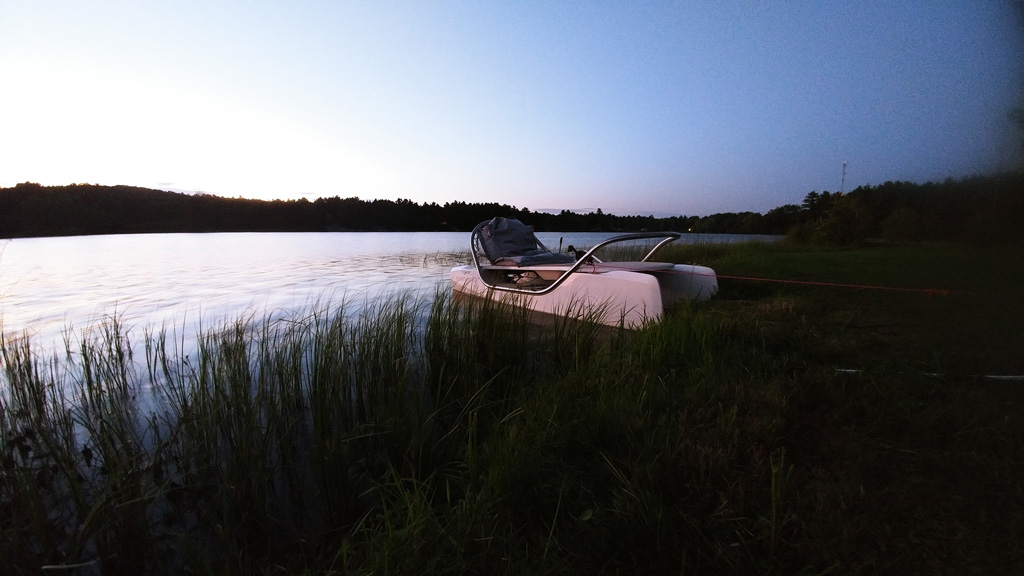
Electric boats have become more and more popular in recent years thanks to both their economical and environmental appeal. Until recently, however, speed and style have never been their main selling points. This is beginning to change with the influx of two new e-boat designs from Sweden and one from Canada that will turn heads as fast as they reduce carbon footprints. Not only are these battery-powered wonders beautiful to look at, they appeal to the adventurous boater’s need for speed, fun, and endurance.
SLEEKER THAN AN EEL

Scandinavia has long been famous for its knack for spare modern design, and Swedish e-boat manufacturer X Shore (xshore.com) is no exception. Founded by entrepreneur and environmentalist Konrad Bergström (picture a hybrid of Elon Musk and Richard Branson), X Shore began working on battery-powered vessels in 2012 and developed a prototype of a 100% electric boat in 2016.
The latest version, the Eelex 8000, is a 26-foot, open-tender vessel that seats six to eight people comfortably and features a low stern, a muscular prow, and a streamlined hull. These features and even the model name itself were inspired by another highly charged aquatic denizen; the South American electric eel that appears on every boat as a solid bronze bow ornament.
Despite the Eelex 8000’s elegant, deceptively streamlined design, it is packed with technology. It uses an array of sensors that capture about 150 data points of the vessel’s environment every second—variables such as boat location, temperature, humidity, air pressure, and pH-levels of the water—to ensure optimum battery and engine performance. The 8000 can also be unlocked and turned on remotely with X Shore’s smartwatch app, while remote diagnostics and “man overboard” features provide enhanced safety measures.
One of the key differences between e-boat and fossil-fuel-based drivetrains is the sound—or lack of it. “At low speeds, around 5 to 10 mph, there is zero sound,” said Jenny Keisu, CEO of X Shore. “We’ve even had to work on noises from small water pumps since they become so noticeable with the lack of traditional noise you’d hear from a diesel engine. You can easily have a conversation, without strain, and the lack of exhaust fumes is very noticeable.”
The 225-kilowatt output from the motor translates to just under 300 brake horsepower (bhp), with high torque at low rpm, Keisu said. This makes the motor perform like an engine twice its size, resulting in snappy acceleration to 35 knots at top speed while cruising at 25 knots. “The high-performance electric motor is proven and will outlast its combustion counterparts,” she added. “And not by a little.”
The earth-friendly elements don’t stop with the engine, either. The Eelex uses the more sustainable cork wood and flax fiber instead of teak for the deck, and carbon fiber for the hull, which comes in hues of moss green, sand, or coffee. The battery pack in the Eelex is no bigger than what one would find in a Tesla automobile. At 120 kilowatt-hours, they provide an effective range of about 100 nautical miles at low speeds, or 50 nautical miles at cruising speed. Using a standard electric vehicle charger, the batteries charge from empty to full in just 5 hours.
X Shore’s up-and-coming e-boat is suited best for use in lakes and as near-shore tenders, where rides start and stop at the same port. Fresh off its dazzling appearance last month at the Palm Beach International Boat Show, the Swedish import has already secured deliveries to a few customers in the United States. “We knew this boat would need to be different than anything consumers have seen, electric or otherwise,” Keisu said. “We expect for [the U.S.] to be our most important market in a short amount of time.”
TAKING FLIGHT
While saving the environment is the main goal with all e-boats, there’s no denying the “coolness factor” of flying. The Candela Speed Boat Seven (candelaspeedboat.com) is considered the world’s first electric hydrofoil watercraft, debuted at the end of 2020 to rave reviews not only in the boating press but in business journals, such as The Economist. Like its X Shore competitor, this other Swedish e-boat maker has begun soaring into the U.S. market.
No, the Candela Seven can’t actually fly, of course. But the effect of the hydrofoils lifting the hull three to four feet over the surface creates an uncanny feeling of piloting a roaring jet just above the waves—only without the roar. The whisper-quiet, 55-kilowatt electric outboard can rarely be heard over the natural wind noise.
Candela even uses aircraft-related nicknames to describe the boat’s performance. The hydrofoils are “wings” and the software that controls them comes from what is called the “flight controller.” The moment the hull lifts up onto the hydrofoils, at about 14 to 17 knots, is referred to as a “takeoff.”
In shallower water, the five-foot-long foil wing is fully retractable into the hull amidships, allowing the 25-foot craft to operate like a conventional boat at lower speeds. The motor can tilt upwards, providing an overall draft of about about 2.3 feet.
The true energy savings begins when the Seven lifts above the surface, said Mikael Mahlberg, communications manager at Candela. With just the wing and three slender struts to provide friction with the water, drag is reduced substantially over a comparable planing boat. Even in choppy seas, with wave heights of four to five feet, the Seven “doesn’t slam into oncoming waves,” it merely rises above and cuts through them, he said.
As a result, energy consumption is 80% less than that of fossil-fuel boats. The top speed is about 30 knots, but running at 18 to 24 horsepower the Seven can achieve a cruising speed of 20 knots, with a range of 50 nautical miles via its 40 kilowatt-hour batteries.
The key to its remarkable stability is the boat’s high-tech brain. The wing below the surface is inherently unstable on its own, Mahlberg explained, “but the boat keeps its balance on the water by constantly adjusting the foil, much the way a fighter plane moves the surface on its wings.” The software also relies on data from a gyroscope, a GPS system, a wave-height sensor, and a barometer to make up to 100 automatic adjustments in the wing per second. The pilot only needs to turn the wheel in a desired direction and the flight controller banks the boat into a stable, smooth turn.
About 30 Candela Seven boats have been sold so far in Europe, Mahlberg said. Since it became available via Denison Yachting and Green Yachts just in November of last year, sales in the U.S. are understandably in the single digits, but the company is still pleased with the initial attention the Candela Seven attracted. Expect to see more on the water this summer.
PEDALING AWAY THE CARBON FOOTPRINT

Could any marine transportation have a smaller carbon footprint than an electric boat? How about one that is powered by your own feet? French-Canadian firm E-Catamaran (e-catamaran.com) is making that pedal-powered dream a reality with the release of the CECLO Cruise—a 13-foot, four-person craft that takes e-boating to a new level.
This is not your standard arduous slog on lakeside paddleboat for tourists. It’s a power-assisted catamaran, using a 500-watt Yamaha electric outboard to tool around at about 3-5 knots. The pedaling is smooth and easy, with very little resistance, providing some exercise for the riders without being too taxing, making it the perfect tender to bring aboard your yacht. Just start pedaling and the engine automatically starts up.
A smaller, two-seat version, called the CECLO Hybrid, is electric as well, but it does have an all-manual pedaling option for those who want to put their pedals to the metal with 100% human power.
Power to the CECLO Cruise is stored in a 12V lithium battery that needs about 4.5 hours to be charged fully, providing about four hours of use. The Cruise is marketed towards people “who enjoy cruising and exploring their favorite waterways and entertaining on the water,” said Marissa Evans, communications manager for E-Catamaran.
The Cruise also comes with a center console, cupholders, and a solar USB charger, Evans said. All of the six models of CECLO boats are fully customizable, with options to include covers, bimini tops, tow trailers, and a choice between Italian composite and full-cork decking.


